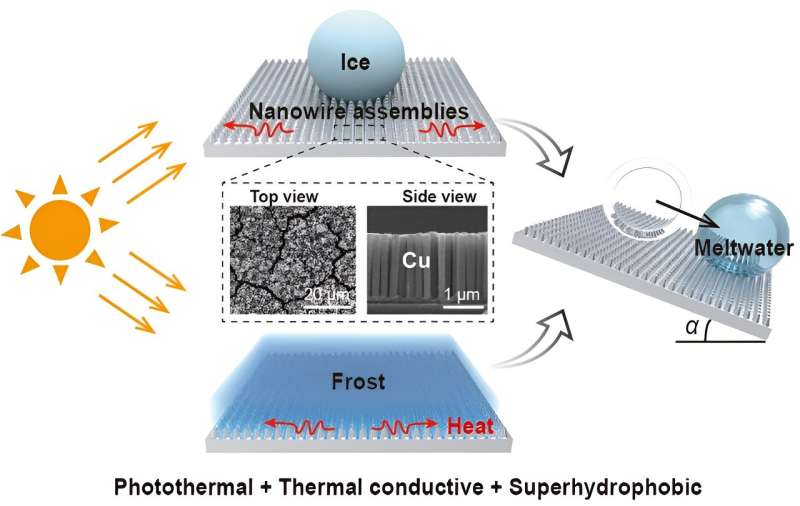This article has been reviewed according to Science X's editorial process and policies. Editors have highlighted the following attributes while ensuring the content's credibility:
fact-checked
proofread
Scientist propose an all-in-one surface design of copper nanowire assemblies to achieve ~100% defrosting efficiency

Scientists at Dalian University of Technology propose a design of copper nanowire assemblies that can sufficiently enhance the de-icing and defrosting efficiency without conventional energy input. Specifically, the defrosting efficacy approaches 100%, a record-high value compared to reported studies.
The research, published in International Journal of Extreme Manufacturing, shows a simple electrochemical method for fabricating nanowire assemblies with controlled pattern, hierarchy, and size. This enables the simultaneous presentation of photothermal, thermal conductive, and superhydrophobic properties, which are otherwise impossible for conventional surfaces.
The photothermal property ensures the efficient sunlight absorption, the thermal conductive property endows the fast lateral heat conduction after sunlight absorption, while the superhydrophobic property propels the sliding or rolling away of ice/frost upon melting from the surface, with the defrosting higher than the previously reported.
Ice and frost buildup continuously pose significant challenges across various fields, ranging from cryogenic freezing of nanoscale cells to flight of macroscale aircraft.
"Traditional de-icing/defrosting solutions mainly rely on mechanical, thermal, and chemical approaches, yet, all of which are either energy-intensive, labor-intensive, or environmentally unfriendly. Additionally, some of these active approaches required direct contact with the material surface, posing risks to delicate coatings. To achieve energy-saving and eco-friendly deicing/defrosting without compromising the surface functionality, most efforts have shifted towards passive approaches via surface modifications," said Siyan Yangthe first author of the paper, who is now a Postdoc at the Hong Kong Polytechnic University.
Recent interest has centered on photothermal surfaces with superhydrophobicity capable of being heated by sunlight, a green energy source abundant on the earth. However, most surfaces suffer from localized and uneven heating due to the inferior thermal conductivity. Thus, further assembling these surface properties with thermally conductive materials, especially metals, holds great potential for de-icing and defrosting, which, yet, remains largely unexplored.
"To address the above issues, we develop a facile fabrication approach to produce controllable copper nanowire assemblies. We found the morphology, height and scale of the assemblies can be well tuned by adjusting the electrochemical parameters. Through wettability and photothermal tests, we found that most of nanowire assemblies can be treated [as] superhydrophobic, with a sunlight absorption rate larger than 95%. Because of the high conductivity of copper materials, nanowire assemblies, especially the design with upright nanowires and an average microgroove width of 2-3 μm, enable superior de-icing and defrosting performances," said Qixun Li (Ph.D student, now at Dalian University of Technology), the first co-author of the paper.
This innovative design can lead to 2-3 times shorter in overall defrosting durations than other three nanostructured surfaces merely with superhydrophobicity, photothermal effect, or a combination thereof. Impressively, this design achieves the highest defrosting efficiency (~100%) compared to previous works.
"In principle, infusing the easy fabrication, high controllability, and diversity in morphology, the design of nanowire assemblies is promising in broad de-icing and defrosting applications that remove the need for traditional energy input. However, the durability, scalability, and chemical stability of the nanowire assemblies are limited in practical applications involving complex working conditions. It is necessary to develop more general micro/nano material processing methods to improve manufacturing efficiency, material scale, and surface durability. Despite this, the design concept of this work serves as a compass for future research endeavors, especially in cold areas facing power shortage," noted Xuehu Ma, a chemical engineering professor at the Dalian University of Technology and the corresponding author of the study.
More information: Siyan Yang et al, Photothermal superhydrophobic copper nanowire assemblies: fabrication and deicing/defrosting applications, International Journal of Extreme Manufacturing (2023). DOI: 10.1088/2631-7990/acef78
Provided by International Journal of Extreme Manufacturing





















